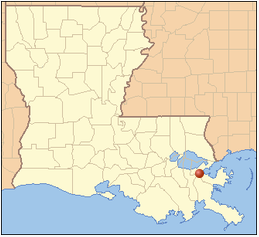| Home | Search | Emissions | Pollutants | About the Database |

Chalmette Refining (1376), Chalmette
LDEQ Accident Report
| Accident # | 147793 |
| State Police # | 13-01405 |
| Accident Date | 2013-04-03 |
| Report Date | 2013-04-10 |
| Follow-up Date | 2013-05-30 |
| Follow-up: | Yes |
Pollutants Released
| Pollutant | Duration | Point Source | Greenhouse Gas | Criteria Pollutant | Ozone forming chemical | Amount of Release |
| Hydrogen Sulfide | 6H | discharge pipe from the Flare 1 knockout drum | NO | NO | NO | 4.2 pounds |
| Benzene | 6H | discharge pipe from the Flare 1 knockout drum | NO | NO | YES | 0.2 pounds |
| Volatile Organic Compounds (VOCs) | 6H | discharge pipe from the Flare 1 knockout drum | NO | NO | YES | BRQ |
| Sulfides | 6H | discharge pipe from the Flare 1 knockout drum | NO | NO | NO | 31.7 pounds |
| Benzene | 6h | discharge pipe from the Flare 1 knockout drum | NO | NO | YES | BRQ |
Accident Classified As: Below Reportable Quantity (BRQ)
Cause of Problem: Corrosion
On Wednesday, April 3, 2013 at approximately 0145, a Chalmette Refining, L.L.C. (CRLLC) operator noticed odors around the waste water treatment plant (WWTP) shelter. At 0225, CRLLC was notified by St. Bernard Parish Sheriff's Office of a community complaint regarding a potential odor. The potential odor issue was communicated to relevant supervisors during the 0400 shift change, and operators continued to investigate the cause of odor during initial rounds. At approximately 0600, CRLLC personnel detected and reported potential odors, and intensified the investigation to identify the source and possible root cause. Personnel identified a leak from a pipe near Tank 5502 at 0645 and positively identified the source as a discharge pipe from the Flare 1 knockout drum at 0708. Moderate to heavy rain water and insulation covering the pipe, made it difficult to identify the leak source. The root cause of failure was determined to be highly localized internal pipe corrosion.
Discharge Preventable - No
The root cause of the pipe leak was determined to be highly localized internal pipe corrosion. Based on the investigation results, CRLLC will: +Identify remaining corrosion in the section of the pipe associated with the leak and replace any sections of pipe that are beyond retirement criteria. +Add additional thickness monitoring points to the interconnecting piping as part of an ongoing piping circuitization inspection effort. +Consider developing equipment strategies to address highly localized pitting in this pipe circuit. The line leak occurred in the interconnected piping located approximately 830 feet downstream of the flare drum outlet that spans a total of 1,590 feet before discharging into Tank 71. Based on recent low corrosion rates and thickness monitoring results, as well as API 570 inspections for piping leaving the flare drum area (2011), interconnecting piping (2008), and near TK 71 (2011), there was no reasonable expectation that high corrosion rates would be seen in the interconnecting piping. While historical inspection records suggested uniform corrosion patters, pipe inspections conducted following discovery of the leak indicate general internal corrosion along the bottom of the interconnected pipe with some spots of highly localized pitting. Despite the thinning, this piping is not beyond retirement criteria. While initial investigation results reveal piping corrosion in the piping area near the leak, highly localized internal corrosion could not be reasonably expected base on previous inspections.
Notes/Remedial Actions
The pipe section with the leak was completely isolated at 0745, then vacuum trucks were utilized to clean up the spilled material. An engineered pipe clamp was installed to eliminate the pipe leak. To minimize any further potential community impacts from the odor, firefighting foam and suppressants were applied to the area possibly affected by the leak. Contaminated soil was remediated. In addition to determining root cause and actions regarding the pipe failure CRLCC has identified two actions to be taken to improve odor management and response: 1. Update guidelines for addressing community odor complaints. 2. Refresh personnel involved in this incident on expectations for documenting odor complaint activities/ observations on written shift change reports. The accident did result in offsite impact because ExxonMobil officials released this claims number for any community members affected: 866-752-6339. The facility made a small mention of the bad smell that permeated throughout the metro area in their letter to LDEQ. According to Exxon's April 10th report, "While there was no impact to ambient air quality standards set by the LDEQ and EPA to protect health and environment, the leak was malodorous given the 245 parts per million mercaptan levels of the sulfur compounds. While there was no impact to ambient air quality standards set by the LDEQ and EPA to protect health and the environment, the leak was malodorous given the 245 parts per million mercaptan levels of the sulfur compounds. The May 30th follow up updates this value to 127 parts per million. According to the 30 day follow up on May 30, 2013: On July 9, 2013 - CRLLC has pledged to participate in the Jefferson Parish LEPC meeting.

Connect With Us: